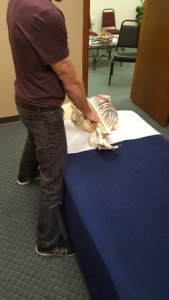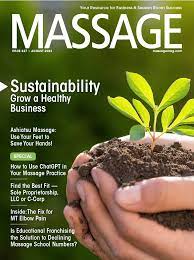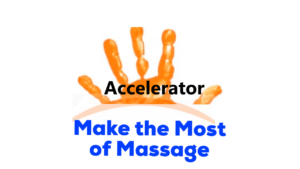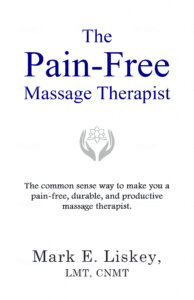As you hunch over your massage table, massage after massage, do you ever get a mental picture of a little, old, humpback woman leaning on her shopping cart in the grocery store? (Suddenly massage body mechanics seem important again, huh?)
You may have tried to counter the massage room hunching with cobras and pec stretches, but who has the time to stretch?
Before you beat yourself up for not stretching, ask yourself this question: Do I have to hunch over my massage table?
The answer is yes.
Just seeing if you were paying attention.
Absolutely not.
In fact, if you do the opposite—get vertical—really good things start to happen.
When I get vertical during a massage my body feels less taxed at the end of a day, especially my upper shoulders and mid-back.
Here’s what I mean by getting vertical: While you’re doing a massage straighten up your torso so that your spine is in a neutral position.

I’m not saying do the whole massage in the vertical position. That would be hard to do (but not impossible).
I’m saying as you work on your massage body mechanics, try to get vertical 25% – 50% of the time during a massage
That will be enough time to give your back a break.
Getting Vertical Formula
My formula for getting vertical is simple. You just need to pay attention to your butt.
When your torso is not over your butt, you’re not vertical.

In this picture you can see that my head is hanging, my upper thoracic spine is rounding and my torso is leaning forward.
There are key times during a massage when you can get vertical.
My favorite time is when doing one-hand static pressure.
1. One-hand static pressure.
I transition into a lot of one-handed presses when I’m doing two-handed massage strokes.
Here I’m doing a two-handed, short stroke glide.

From this position, I simply turn both feet to my right and switch to one-hand static pressure

My feet are parallel to the side of the table, and I regulate my pressure through my stance. With a wider stance I have less leaning leverage. A narrow stance gives me more leaning leverage.
If I want to give my working arm a break, I can turn the opposite way and use my other hand on the same spot or another spot.

I also like getting vertical when I can squat.
2. Squat.
When I squat I can direct my pressure by simply shifting my weight from the back of my feet to the front of my feet or from my heels to the balls of my feet.
Working on necks and feet are perfect for squatting.
Here I am pressing into cervical erectors.

To exert more pressure, I lean in (shift my weight to the balls of my feet).
Feet are also a time to get vertical.

The wide stance allows me to get my butt under my torso.
When you experiment with stances and one-hand static pressure you’ll find your own ways to get vertical.
Here’s a more complex move that still has good, vertical massage-body-mechanics.

In this picture I’m using a T-bar on the upper trap/levator scapulae (or where the upper trap and levator scapulae would be if my skeleton was a person).
To rest my shoulder and neck, I have my arm against the front of my torso, and I’m generating pressure by simply pushing with my legs, not my shoulder.
Jonesing for Vertical
The downside of getting vertical during a massage is that it’s addictive. Once you get vertical, you’re going to want to get more vertical.
This is a one-hand press with a stretch.

Your back will love this.
Here’s the going vertical Cliff’s Notes:
Advanced Massage Body Mechanics: Going Vertical Recap
- Keep your butt under your torso.
- Go vertical when you switch to one hand.
- Go vertical when squatting.
Body Mechanics CE Course That Will Save Your Body
If you need more help with massage body mechanics, growing a massage business or making more money, check out my online, home-study, CE course here.







Comments on this entry are closed.